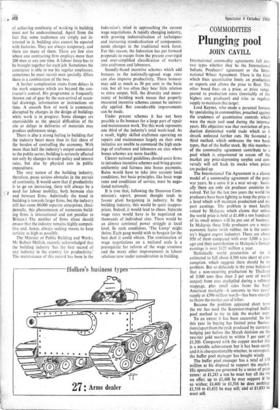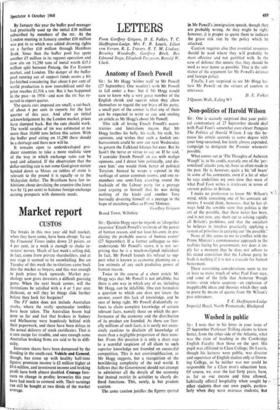Plunging pool
COMMODITIES JOHN CAVILL
International commodity agreements fall into two types whether they be the International Sultana Producers' agreement or the Inter- national Wheat Agreement. There is the kind which fixes quantitative limits on production or exports and allows the price to float. The other breed fixes on a price, or price range. geared to production costs (inevitably of the highest cost producer) and tries to regulate supply to maintain this target.
Lord Keynes, who made a personal fortune by speculating in commodities, preached against the crudeness of quantitative controls which were the main tool used during the interwar years. His objection was that restriction of pro- duction diminished world trade which as it shrank enforced further cuts. He favoured a third method, which embraces the two basic types, that of the buffer stock. By this members of the commodity agreement contribute to a pool which is empowered to cream off the market any price-depressing surplus and con- versely will sell back its stocks when prices are pushed up.
The International Tin Agreement is a classic model of a commodity agreement of the post- war years. In a sense it is a neat set-up: basic- ally there are only six producer countries in- volved. Yet for the last two years the world tin producers have been fighting to keep the price at a level which will maintain production. and ex- port earnings. The problem is -most loudly voiced 'by Malaysia which claims that unless the world price is held at £1.400 a ton hundreds of its small miners will be put out of business. In Malaysia these little producers are a major economic factor (with rubber, tin is the coun- try's biggest export industry). There are about 950 of them compared with over 1,000 a year ago and their contribution to Malaysia's foreign earnings is over $125 million a year.
Statistically - world production of tin is estimated to fall about 4,500 tons short of con- sumption, which suggests there should be no problem. But so delicately is the price balanced that a non-recurring production by Thailand of 3,000 tons (less than 2 per cent of world output) from ores stockpiled during a refinery stoppage, plus small sales from the huge American stockpile—it amounts to two years' supply or £390 million worth—has been enough to throw the market out of kilter.
Because the problem appeared short term the rrc has used the Keynsian-inspired buffer pool method to try to tide the market over. To an extent it has been successful. So far this year its buying has limited price' fluctua- tions (apart from the peak produced by currency hedging just before the March decision on the two-tier gold market) to within 5 per cent of £1,300. Compared with the copper market this is a notable achievement but it has been costly and it is also questionable whether, in retrospect, the buffer pool manager has bought wisely. The buffer pool manager has a total of £30 milliOn at his disposal to support the market. His operations are governed by a series of price zones: at £1,283 a ton he must buy all the tin on offer; up to £1,400 be may support if he so wishes; £1,400 to £1,516 he does nothing: £1,516 to £1,633 he may sell; and at £1,633 be must sell. By January this year the buffer pool.manager had practically used up the initial £10 million subscribed by members of the rrc. At the London meeting in January another £10 million was put in to which was added drawing rights on a further £10 million through Hambros Bank. Since then the buffer pool has spent another £5 million in its support operation and now sits on 11,290 tons of metal worth £15.1 million split between Penang, the Far Eastern market, and London. The danger of the buffer pool running out of support funds seems a bit far-fetched considering that about 6 per cent of world production is now immobilised until the price reaches £1,516 a ton. But it has happened in the past—in 1954—and now the ITC has re- sorted to export quotas.
The quota cuts imposed are small; a cut-back of about 4 per cent in exports for the last quarter of this year. And after an initial acknowledgement by the London market, prices have slumped back. But the cuts should work. The world surplus of tin was estimated at no more than 10,000 tons before this action. With the buffer pool sitting on 11,290 there should be a shortage and there now will be.
It remains open to underdeveloped pro- ducer countries to take a more realistic view of the way in which exchange rates can be used and adjusted. If the observation that the dollar-sterling rate is not some God-given statute handed down to Moses on tablets of stone is relevant to the pound it is equally so to the Malaysian dollar. The Brazilians have few in- hibitions about devaluing the cruzeiro (the latest was by It per cent) to balance foreign exchange earning prospects with domestic needs.







































 Previous page
Previous page